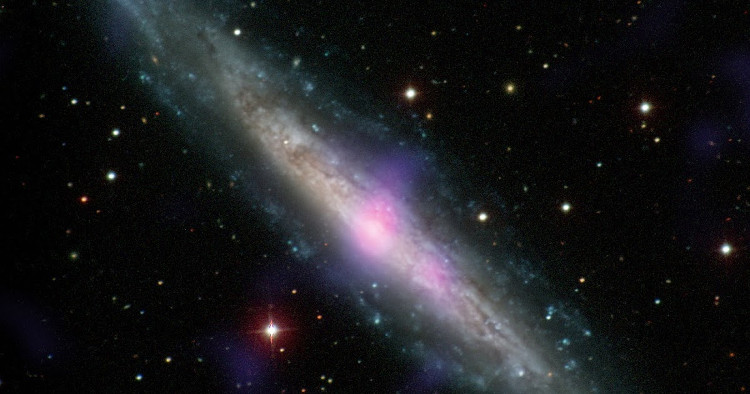Discovered two giant black holes lurking in galaxies near us
A new study confirms the existence of two supermassive black holes in galaxies near us. They were previously hidden by clouds of gas and dust, obscuring high-energy explosions formed when cosmic matter was sucked into their space.
"These black holes are relatively close to the Milky Way, but they are still hidden from us until now. They are like monsters hiding under your bed , " said Ady Annuar researcher. from Durham University (England), a member of the black hole team at the galaxy center NGC 1448 .
Huge black holes are really invisible to us, because they don't emit light. However, when matter falls across the boundary of the event horizon, they heat up and produce radiation that can be observed on the electromagnetic spectrum. This process at the center of the galaxy contains a supermassive black hole, creating a brilliant performance that can be found billions of light years away, but only with favorable conditions.

Image of galaxy NGC 1448.
The problem is that the most active nuclei are thought to be surrounded by gas and dust clouds that block most of the light emitted. If you have an advantage to observe, you will see an incredible light show, but when you look from the side, you may not see anything.
"Just as we can't see the sun on a cloudy day, we can't directly see how the galactic cores really shine because gas and dust surround the active central area." , Peter Boorman from the University of Southampton (UK), who led a study of black holes in galaxy IC 3639 , said. "As the level of obscurity increases, only the most energetic X-rays can escape to be observed by us," he added.
New discoveries can be made by NASA's NuSTAR (Nuclear Spectroscopic Telescope Array) - an X-ray telescope located in space. Using NuSTAR, Boorman's team measured high-energy X-ray emissions from IC3639, a galaxy 170 million light-years from Earth, a relatively close distance, when the universe itself is thought to be about 45 billion light years.
IC 3639 was previously observed by NASA's Chandra X-ray observatory and Japan's Suzaku satellite, but new data from NuSTAR are the first to confirm that this galaxy actually has a galactic nucleus. work.

Galaxy IC 3639.
" Black hole (in IC 3639) is very faint, it requires extremely sensitive observations in the X-ray region with the highest energy to classify it as obscured. IC 3639 turns out to be extremely bright glowing due to the glowing from hot iron molecules, which have so far not been fully understood , " Boorman said.
In another study, Annuar's team also used NuSTAR to observe a giant black hole that is even closer to Earth, at a distance of 38 million light years, ie about 360 trillion kilometers, so No need to worry there are some surprises in the space around us in the near future.
"Recent discoveries certainly suggest that there are so many other supermassive black holes that we are still ignoring, even in our neighborhood space," Annuar said.
- Millions of black holes are hiding in our galaxy
- The galaxy has 3 black holes
- The supermassive black hole 'carnivores' from the inside
- Three huge black holes are about to collide in the universe
- NASA discovered the giant galaxy surrounding the cosmic black hole
- Milky Way between the black hole fin
- Observing the scene where two galaxies collide creates black holes
- Unexpectedly discovered 5 mysterious black holes in the universe
- For the first time, two black holes revolved around each other
- Detected stunned the power of the supermassive black holes
- The largest black holes in the universe
- Discover a giant galaxy and a great black hole away from the Milky Way
 Van Allen's belt and evidence that the Apollo 11 mission to the Moon was myth
Van Allen's belt and evidence that the Apollo 11 mission to the Moon was myth The levels of civilization in the universe (Kardashev scale)
The levels of civilization in the universe (Kardashev scale) Today Mars, the sun and the Earth are aligned
Today Mars, the sun and the Earth are aligned The Amazon owner announced a secret plan to build a space base for thousands of people
The Amazon owner announced a secret plan to build a space base for thousands of people The nearest black hole discovered is only 150 light years from Earth
The nearest black hole discovered is only 150 light years from Earth  New discovery of the oldest black hole in the universe
New discovery of the oldest black hole in the universe  The Black Pyramid and the tragedy of deep oblivion: A thousand years later, still no escape from the tragedy of tomb raiding
The Black Pyramid and the tragedy of deep oblivion: A thousand years later, still no escape from the tragedy of tomb raiding  Exploring the 'Black Box of the Earth' project: A device that records the process of human extinction
Exploring the 'Black Box of the Earth' project: A device that records the process of human extinction  Finding the mysterious 'monster' that is making the universe expand
Finding the mysterious 'monster' that is making the universe expand  Why do images of black holes appear to be burning from the outside?
Why do images of black holes appear to be burning from the outside? 